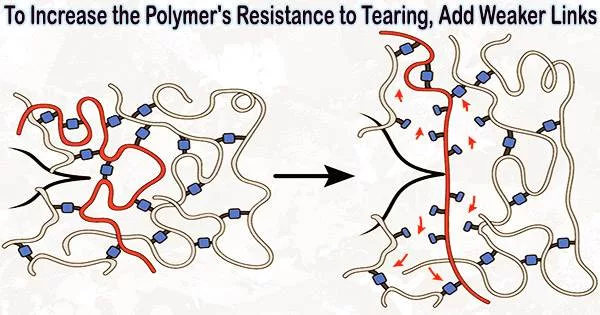A group of scientists from MIT and Duke University have found a paradoxical method to strengthen polymers by adding a few weaker bonds to the substance.
The researchers discovered that by just utilizing a weaker type of crosslinker to attach parts of the polymer building blocks, they could boost the materials’ resistance to tearing by up to tenfold when working with a class of polymer known as polyacrylate elastomers.
In addition to being frequently utilized in automobile parts, these rubber-like polymers are frequently employed as the “ink” for 3D-printed products. Currently, the researchers are looking into the possibility of applying this methodology to different kinds of materials, like rubber tires.
“If you could make a rubber tire 10 times more resistant to tearing, that could have a dramatic impact on the lifetime of the tire and on the amount of microplastic waste that breaks off,” says Jeremiah Johnson, a professor of chemistry at MIT and one of the senior authors of the study, which appears in Science.
The fact that this method doesn’t seem to change any of the polymers’ other physical characteristics is a huge benefit.
“Polymer engineers know how to make materials tougher, but it invariably involves changing some other property of the material that you don’t want to change. Here, the toughness enhancement comes without any other significant change in physical properties at least that we can measure and it is brought about through the replacement of only a small fraction of the overall material,” says Stephen Craig, a professor of chemistry at Duke University who is also a senior author of the paper.
This project grew out of a longstanding collaboration between Johnson, Craig, and Duke University Professor Michael Rubinstein, who is also a senior author of the paper. The paper’s lead author is Shu Wang, an MIT postdoc who earned his Ph.D. at Duke.
Polymer engineers know how to make materials tougher, but it invariably involves changing some other property of the material that you don’t want to change. Here, the toughness enhancement comes without any other significant change in physical properties at least that we can measure and it is brought about through the replacement of only a small fraction of the overall material.
Professor Stephen Craig
The weakest link
Polymer networks comprised of acrylate strands kept together by connecting molecules are known as polyacrylate elastomers. These components can be put together in many ways to produce materials with various qualities.
One architecture often used for these polymers is a star polymer network. Two different types of building blocks are used to create these polymers: one is a star with four identical arms, and the other is a chain that serves as a linker. These linkers connect to the tips of each star’s arm to form a network like a volleyball net.
In a 2021 study, Craig, Rubinstein, and MIT Professor Bradley Olsen teamed up to measure the strength of these polymers. As predicted, they discovered that the material weakened when weaker end-linkers were utilized to bind the polymer strands together. When compared to the linkers that are often employed to join these building blocks, those weaker linkers, which contain cyclic molecules known as cyclobutane, can be broken with a lot less power.
Following up on that research, the scientists made the decision to look into a different kind of polymer network where the polymer strands are randomly cross-linked to one another rather than being united at the ends.
This time, the researchers discovered that the material became significantly more tear-resistant when weaker linkers were utilized to connect the acrylate building blocks together.
The reason for this, according to the researchers, is that the weaker links are randomly distributed throughout the material as junctions between otherwise strong strands rather than being a part of the ultimate strands themselves.
Any cracks that form when this material is stretched past its breaking point attempt to bypass the stronger bonds and instead pass through the weaker ones. As a result, more bonds must be broken by the crack than would be necessary if all of the bonds had the same strength.
“Even though those bonds are weaker, more of them end up needing to be broken, because the crack takes a path through the weakest bonds, which ends up being a longer path,” Johnson says.
Tough materials
Using this method, the researchers demonstrated that weaker linkers in polyacrylates made with stronger crosslinking molecules were nine to ten times more difficult to shred than weaker linkers in polyacrylates made with other weaker linkers. Even though the weak crosslinkers made up only around 2% of the material’s overall composition, this result was nevertheless obtained.
Additionally, the researchers demonstrated that the material’s other features, such as its resistance to degrading under heat, were unaffected by the composition change.
“For two materials to have the same structure and same properties at the network level, but have an almost order of magnitude difference in tearing, is quite rare,” Johnson says.
he researchers are currently exploring the possibility of using this strategy to increase the hardness of other materials, such as rubber.
















